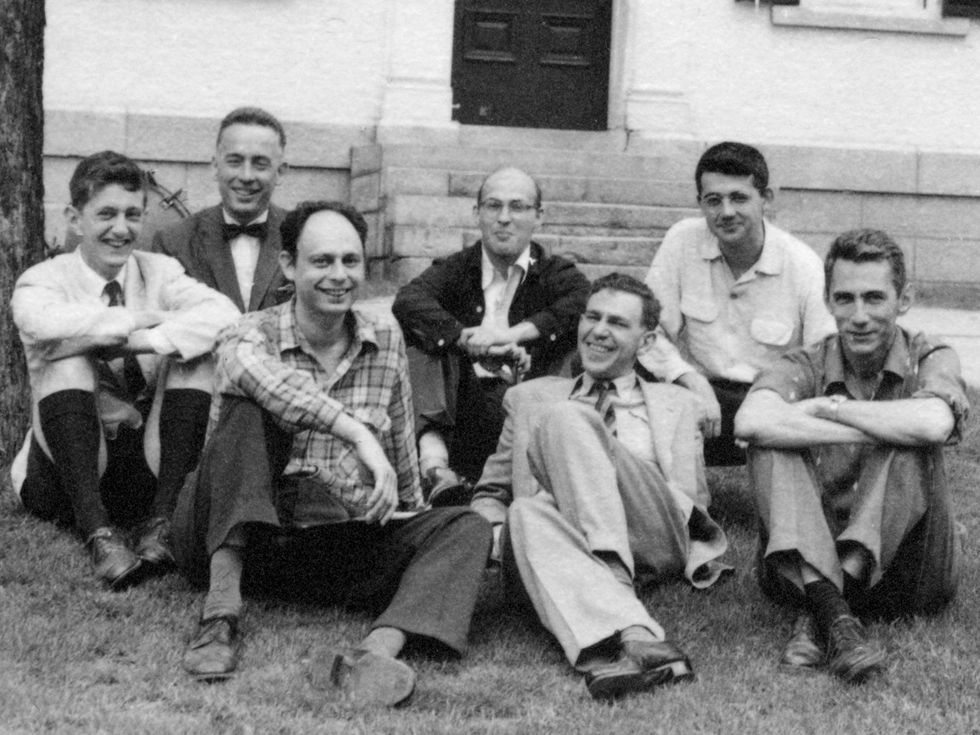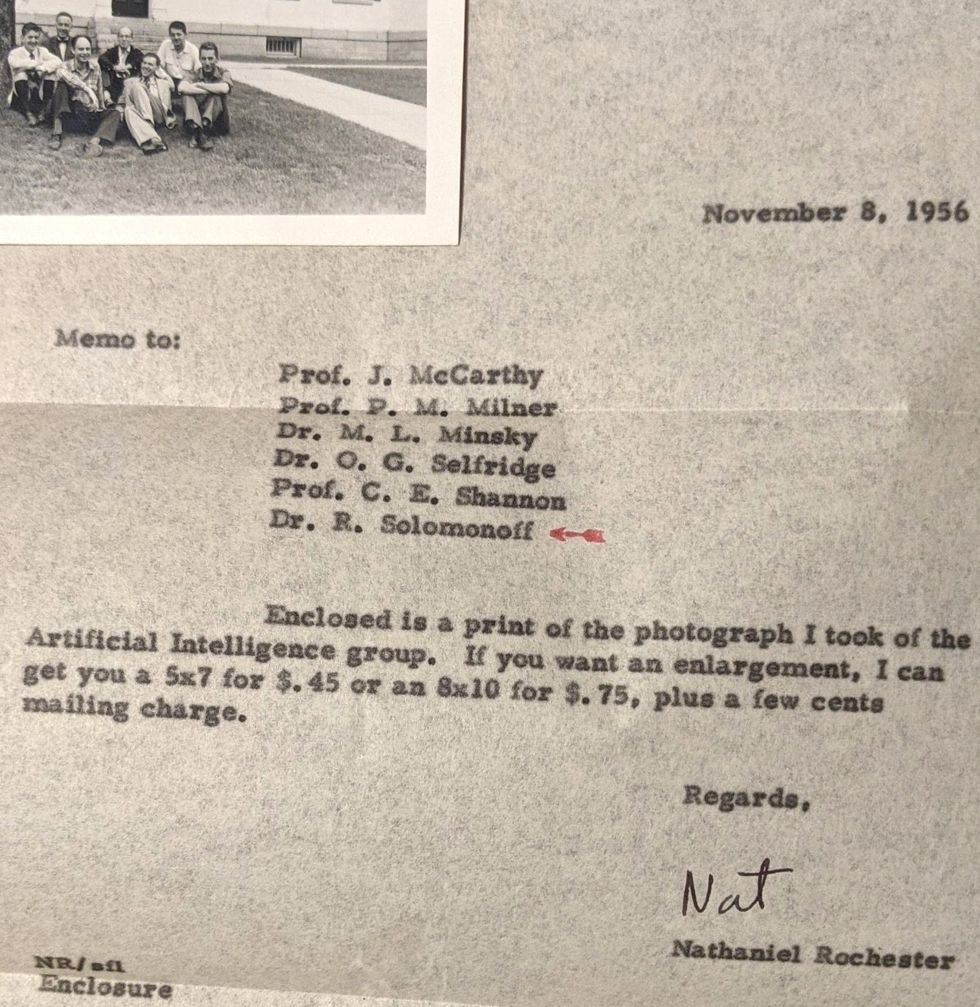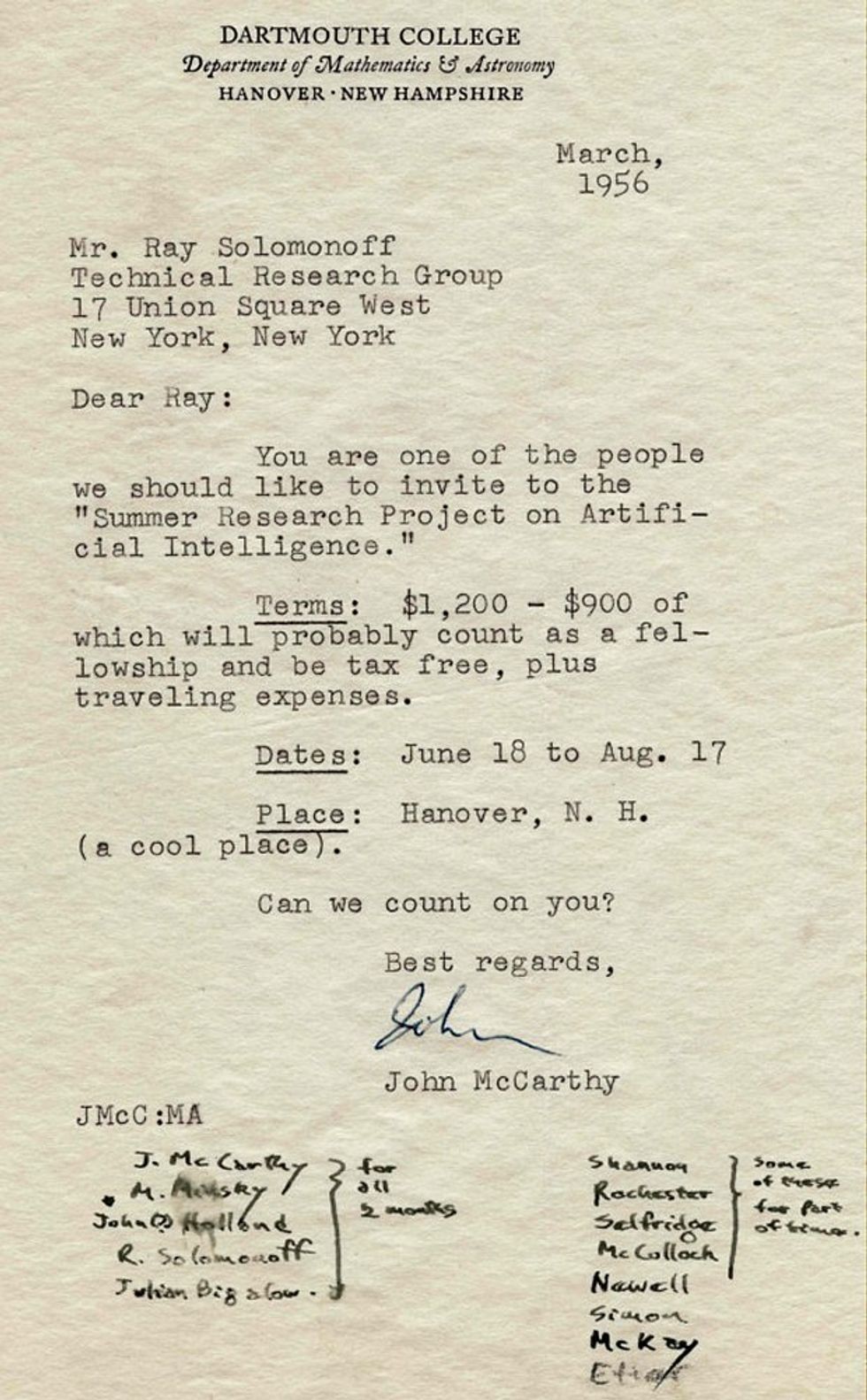The Meeting of the Minds That Launched AI

The Dartmouth Summer Research Project on Artificial Intelligence, held from 18 June through 17 August of 1956, is widely considered the event that kicked off AI as a research discipline. Organized by John McCarthy, Marvin Minsky, Claude Shannon, and Nathaniel Rochester, it brought together a few dozen of the leading thinkers in AI, computer science, and information theory to map out future paths for investigation.
A group photo [shown above] captured seven of the main participants. When the photo was reprinted in Eliza Strickland's October 2021 article The Turbulent Past and Uncertain Future of Artificial Intelligence" in IEEE Spectrum, the caption identified six people, plus one unknown." So who was this unknown person?
Who is in the photo?Six of the people in the photo are easy to identify. In the back row, from left to right, we see Oliver Selfridge, Nathaniel Rochester, Marvin Minsky, and John McCarthy. Sitting in front on the left is Ray Solomonoff, and on the right, Claude Shannon. All six contributed to AI, computer science, or related fields in the decades following the Dartmouth workshop.
 In the back row from left to right are Oliver Selfridge, Nathaniel Rochester, Marvin Minsky, and John McCarthy. In front on the left is Ray Solomonoff; on the right, Claude Shannon. The identity of the person between Solomonoff and Shannon remained a mystery for some time.The Minsky Family
In the back row from left to right are Oliver Selfridge, Nathaniel Rochester, Marvin Minsky, and John McCarthy. In front on the left is Ray Solomonoff; on the right, Claude Shannon. The identity of the person between Solomonoff and Shannon remained a mystery for some time.The Minsky Family
Between Solomonoff and Shannon is the unknown person. Over the years, some people suggested that this was Trenchard More, another AI expert who attended the workshop.
I first ran across the Dartmouth group photo in 2018, when I was gathering material for Ray's memorial website. Ray and I had met in 1969, and we got married in 1989; he passed away in late 2009. Over the years, I had attended a number of his talks, and I had met many of Ray's peers and colleagues in AI, so I was curious about the photo.
I thought, Gee, that guy in the middle doesn't look like my memory of Trenchard." So I called up Trenchard's son Paul More. He assured me that the unknown person was not his father.
More recently, I discovered a letter among Ray's papers. On 8 November 1956, Nat Rochester sent a short note and a copy of the photo to some colleagues: Enclosed is a print of the photograph I took of the Artificial Intelligence group." He sent his note to McCarthy, Minsky, Selfridge, Shannon, Solomonoff-and Peter Milner.
 Several months after the workshop, Nathaniel Rochester sent a copy of the photo, along with this note, to six people.Grace Solomonoff
Several months after the workshop, Nathaniel Rochester sent a copy of the photo, along with this note, to six people.Grace Solomonoff
So the unknown person must be Milner! This makes perfect sense. Milner was working on neuropsychology at McGill University, in Montreal, although he had trained as an electrical engineer. He's not generally lumped in with the other AI pioneers because his research interests diverged from theirs. Even at Dartmouth, he felt he was in over his head, as he wrote in his 1999 autobiography: I was invited to a meeting of computer scientists and information theorists at Dartmouth College.... Most of the time I had no idea what they were talking about."
In his fascinating autobiography, Milner writes about his work in radar development during World War II, and his switch after the war from nuclear-reactor design to psychology. His doctoral thesis in 1954, Effects of Intracranial Stimulation on Rat Behaviour," examined the effects of electrical stimulation on certain rat neurons, which became widely and enthusiastically known as pleasure centers."
This work led to one of Milner's most famous papers, The Cell Assembly: Mark II," in 1957. The paper describes how, when a neuron in the brain fires, it excites similar connected neurons (especially those already aroused by sensory input) and randomly excites other cortical neurons. Cells may form assemblies and connect with other assemblies. But the neurons don't seem to exhibit the same snowballing behavior of atoms that leads to an exponential explosion. How neurons might inhibit this effect were among his ideas that led to new insights at the workshop.
Milner's work contributed to the early development of artificial neural networks, and it's why he was included in the Dartmouth meeting. There was considerable interest among AI researchers in studying the brain and neurons in order to reproduce its functions and intelligence.
But as Strickland notes in her October 2021 Spectrum article, a division was already forming in AI research. One side focused on replicating the brain, while the other was more interested in what the mind might do to directly solve problems. Scientists interested in this latter approach were also represented at Dartmouth and later championed the rise of symbolic logic, using heuristic and algorithmic processes, which I'll discuss in a bit.
Where Was the Photo Taken?Rochester's photo from 1956 shows the left-hand side of Dartmouth Hall in the background. In 2006 Dartmouth convened a conference, AI@50, to celebrate the 50th anniversary of the AI gathering and to discuss AI's present and future. Trenchard More, the person most often misidentified as the unknown person" in Nat's photo, met with the organizers, James Moor and Carey Heckman, as well as Wendy Conquest, who was working on a movie about AI for the conference. None of the AI@50 organizers knew exactly where the 1956 meeting had taken place.
More led them across the lawn and to the left-hand side door of Dartmouth Hall. He showed them the rooms that were used, which in turn triggered an old memory. During the 1956 meeting, as More recalled in a 2011 interview, Selfridge, and Minsky, and McCarthy, and Ray Solomonoff, and I gathered around a dictionary on a stand to look up the word heuristic, because we thought that might be a useful word." On that 2006 tour of Dartmouth Hall, he was delighted to find that the dictionary was still there.
The word heuristic was invoked all through the summer of 1956. Instead of trying to analyze the brain to develop machine intelligence, some participants focused on the operational steps needed to solve a given problem, making particular use of heuristic methods to quickly identify the steps.
Early in the summer, for instance, Herb Simon and Alan Newell gave a talk on a program they had written, the logic theory machine. The program relied on early ideas of symbolic logic, with algorithmic steps and heuristic guidance in list form. They later won the 1975 Turing Award for these ideas. Think of heuristics as intuitive guides. The logic theory machine used such guides to initiate the algorithmic steps-that is, the set of instructions to actually carry out the problem solving.
There was one person who was at the Dartmouth Workshop from time to time but was never included in any of the lists of attendees: Gloria Minsky, Marvin's wife.
But Gloria was definitely a presence that summer. Marvin, Ray, and John McCarthy were the only three participants to stay for the entire eight-week workshop. Everyone else came and went as their schedules allowed. At the time, Gloria was a pediatrics fellow at Children's Hospital in Boston, but whenever she could, she would drive up to Dartmouth, stay in Marvin's apartment, and visit with whoever was at the workshop.
Several years earlier, in the spring of 1952, Gloria had been doing her residency in pathology at New York's Bellevue Hospital, when she began dating Marvin. Marvin was a Ph.D. student at Princeton, as was McCarthy, and the two were invited to Bell Labs for the summer to work under Claude Shannon. In July, just four months after their first meeting, Gloria and Marvin got married. Although Marvin was working nonstop for Shannon, Shannon insisted he and Gloria take a honeymoon in New Mexico.
 In March 1956, John McCarthy, one of the Dartmouth AI workshop's organizers, invited Ray Solomonoff to the summer workshop in Hanover, N.H.Grace Solomonoff
In March 1956, John McCarthy, one of the Dartmouth AI workshop's organizers, invited Ray Solomonoff to the summer workshop in Hanover, N.H.Grace Solomonoff
Four years later, McCarthy, Shannon, and Minsky, along with Nat Rochester, organized the Dartmouth workshop. Gloria remembered a conversation between her husband and Ray, in which Marvin expressed a thought that later became one of his hallmarks: You need to see something in more than one way to understand it." In Minsky's 2007 book The Emotion Machine, he looked at how emotions, intuitions, and feelings create different descriptions and provide different ways of looking at things. He tended to favor symbolic logic and deductive methods in AI, which he called good old-fashioned AI."
Ray, meanwhile, was focused on probabilities-the likelihood of something happening and predictions of how it might evolve. He later developed algorithmic probability, an early version of algorithmic information theory, in which each different description of something leads with a probabilistic likelihood (some more likely, some less likely) of a given outcome in the future. Probabilistic methods eventually became the underpinnings of machine learning.
These days, as chatbots enter the limelight, and compression methods are used more in AI, the value of understanding things in many ways and using probabilistic predictions will only grow in importance. That is, logic and probability methods are uniting. These in turn are being aided by new work on neural nets as well as symbolic logic. And so the photo that Nat Rochester took not only captured a moment in time for AI. It also offered a glimpse into how AI would develop.
The author thanks Gloria Minsky, Margaret Minsky, Nicholas Rochester, Julie Sussman, Gerald Jay Sussman, and Paul More for their help and patience.